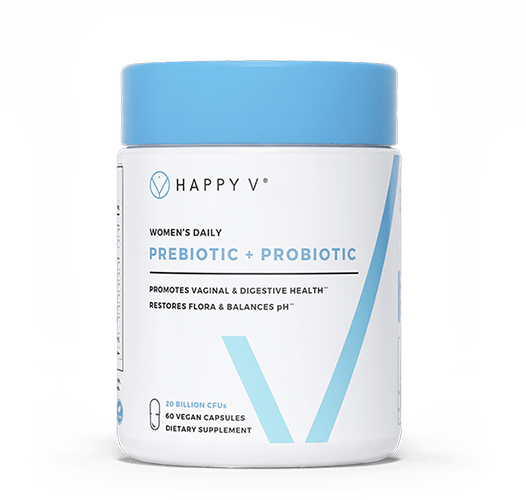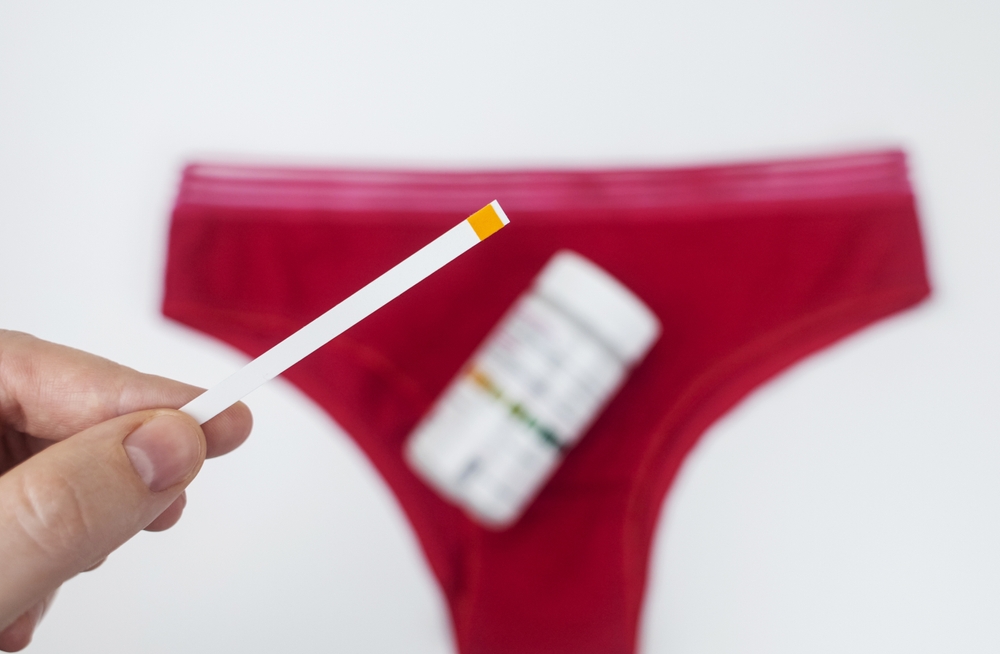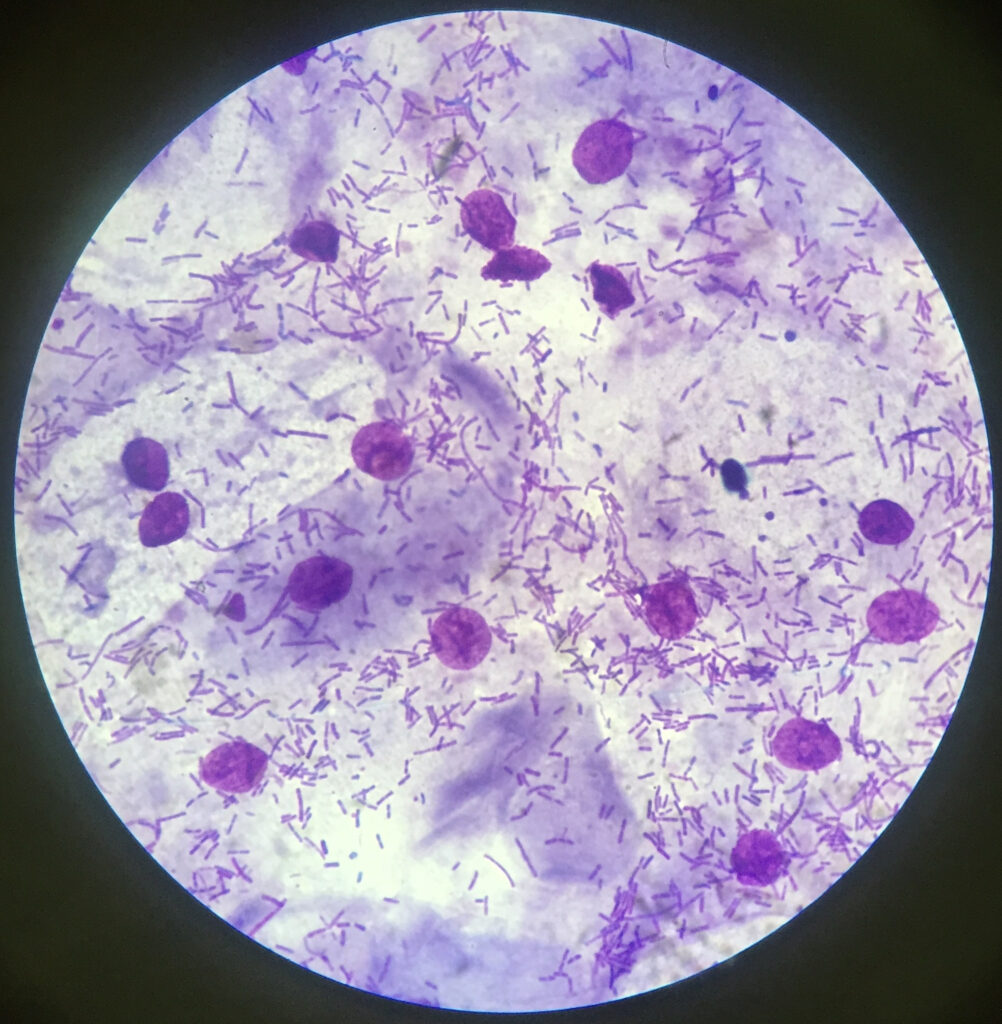- The pH level of a healthy vagina is slightly acidic, between 3.8 and 4.5. This acidity maintains good bacteria’s growth while preventing bad bacteria’s growth.
- Abnormal vaginal pH levels make you more prone to common vaginal infections, including bacterial vaginosis and vaginal yeast infections.
- Some of the most common culprits for vaginal pH imbalance include poor vaginal hygiene, douching, overuse of antibiotics, pregnancy, contraception, unprotected sex, and menopause.
- You can restore and maintain ideal vaginal pH levels through lifestyle changes, including increasing hydration, reducing added sugars, and taking a daily prebiotic+ probiotic supplement.
Your vaginal pH is a little number that can tell you a whole lot about your overall vaginal wellness, but it’s an aspect of women’s health that’s often overlooked. So let’s give vaginal pH its due. Think of this as Vaginal pH 101. Throughout this article, we’ll give you a better understanding of what vaginal pH is, what factors affect it, and how you can monitor it, so you can ultimately feel more empowered to take charge of your body and your health.
What is Vaginal pH?

To understand what vaginal pH is, we have to understand what pH is more generally. pH describes how acidic or basic a particular substance is. pH levels are measured on a scale from 1 to 14, with 1 being incredibly acidic and 14 being incredibly basic or alkaline. Things like lemons and vinegar are acidic, while baking soda, tofu, and nuts are usually alkaline. In the middle, we have 7, which is neutral, or the pH of water.
So when we describe your vaginal pH, we’re describing how acidic or basic the vagina is. Other areas of your body also have pH, though. Your stomach, for example, has an incredibly acidic pH between 1.5 and 3.5 to help break down food and kill bad bacteria that enter the stomach. Your skin is also slightly acidic, with a pH between 4.5 and 6.5. This also serves to kill any bacteria that may land on the skin and prevent it from causing infection.
If you haven’t yet, read our Ultimate Guide to Bacterial Vaginosis to get a better understanding of what Bacterial Vaginosis is and why pH is so important.
What is the pH of a healthy vagina?
Usually, healthy vaginas have a pH ranging between 3.8-4.5 1, but it can vary depending on your age. The 3.8-4.5 range is typical for women of reproductive age (so about age 12 through menopause). But for prepubescent girls or post-menopausal women, the pH level can be greater than 4.5.2
Things like menstruation and your menstrual cycle can cause this pH level to change temporarily, but more prolonged changes in vaginal pH levels can lead to frequent vaginal infections like bacterial vaginosis (BV) or vaginal yeast infections.
If you’re reading this article because you’re struggling with recurrent BV and want to understand more about the link between BV and pH, check out our Ultimate Guide to Bacterial Vaginosis.
Why is the ideal pH of the vagina acidic?
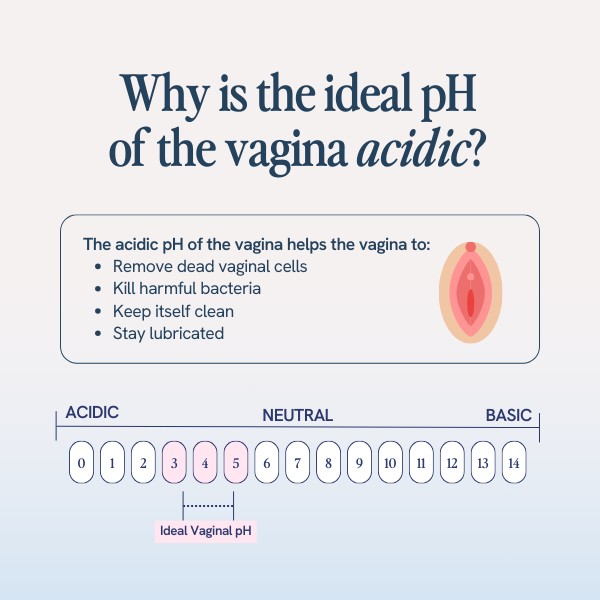
The pH level of a healthy vagina is slightly acidic, and I know you might be thinking, “Wait… acid in my vagina?!” but this slight acidity is a very good thing.
The acidic pH of the vagina helps the vagina to:
- Keep itself clean
- Remove dead vaginal cells
- Stay lubricated
- Kill harmful bacteria out of your vagina
Your vagina actually gets its acidity thanks to the presence of certain good bacteria. While every person has slightly different vaginal microbiomes, all healthy vaginas contain bacteria from the Lactobacilli species (L. Acidophilus, L. crispatus, L. iners, L. rhamnosus) and Bifidobacteria.
These bacteria, particularly that Lactobacillus, convert glucose into hydrogen peroxide and lactic acid, which both work to kill bad bacteria like Gardnerella vaginalis, Atopobium, and Mycoplasma, which cause BV and also kill fungi like Candida albican, which causes most vaginal yeast infections.
What happens when my vaginal pH is abnormal?

A vaginal pH above 4.5 means your Lactobacilli have slowed or stopped the production of lactic acid and hydrogen peroxide, and your body has lost its natural defense against those common pathogens we mentioned above. This leads to increased prevalence of three things: UTIs, BV, and vaginal yeast infections. Let’s dive into those latter two a bit more now.
Bacterial vaginosis (BV)
BV is one of the most common vaginal infections in women between 14 and 49. In fact, according to the CDC, BV affects about 29.2% of women annually. And that’s just in the US alone.4
Though there is a strong link between certain sexual practices and BV, it’s important to know that BV is not a sexually transmitted disease (STD) or a sexually transmitted infection (STI).
Half of women don’t experience any symptoms of BV, which is why it’s so important to maintain annual appointments with a gynecologist. But for those who do experience symptoms of BV, those typically include:
- Unusual vaginal discharge that’s usually white or grey
- Itching or burning sensation around the vulva
- Foul-smelling discharge that many describe as fish-like and is more noticeable after sex
- Burning sensation during urination
Luckily, BV is highly treatable thanks to antibiotics like metronidazole, clindamycin, or tinidazole, all of which can be prescribed by a doctor. There are also natural ways to minimize the risk of getting BV, such as through the use of a daily prebiotic + probiotic supplement, which keeps the vagina populated with that healthy Lactobacilli.
And the prevention and treatment of BV, even asymptomatic BV, is critical since untreated BV has been linked to severe complications, including:
- Increased risk of contracting STDs like herpes, gonorrhea, and HIV
- Pelvic inflammatory disease (PID) in either the uterus or ovaries
- Early labor or preterm birth
- Increased risk of infections after any surgery on your female organs, such as a hysterectomy or cesarean section
Vaginal yeast infections
After BV, vaginal yeast infections, also called vaginal candidiasis, vulvovaginal candidiasis, or candidal vaginitis., is the second-most common vaginal infection.5 It occurs when the vaginal pH becomes less acidic and cannot fight off the growth of a yeast called Candida albicans.6
Certain yeast infection symptoms, like burning while urinating, can be similar to BV, so it’s important to go to a doctor to get a correct diagnosis. However, there are key differences, particularly in the odor and color of the vaginal discharge. Unlike BV, the discharge associated with yeast infections is odorless, with a thick cottage cheese-like consistency.
Vaginal yeast infections are also highly treatable, and your doctor might prescribe antifungal medications such as fluconazole that can be taken by mouth or applied inside the vagina.
How can I tell if my vaginal pH levels are off?

Initial or temporary changes to your vaginal pH are often asymptomatic, meaning they don’t show any signs.
But if you ever experience an infection like BV, a vaginal yeast infection, or a UTI, these are typical signs that your vaginal pH levels are off and your vagina is unable to fight off infections.7
Some other common signs and symptoms of pH imbalance are:
- Burning sensation while urinating
- Inflammation in your vagina
- Itchiness around your vulva
- Pain during sex
- Unusual vaginal odor
- Unusual discharge
- Vaginal dryness
If you’re experiencing one or more of the symptoms mentioned above, it is best to seek professional help from a healthcare provider as soon as possible.
Can I check my vagina’s pH at home?
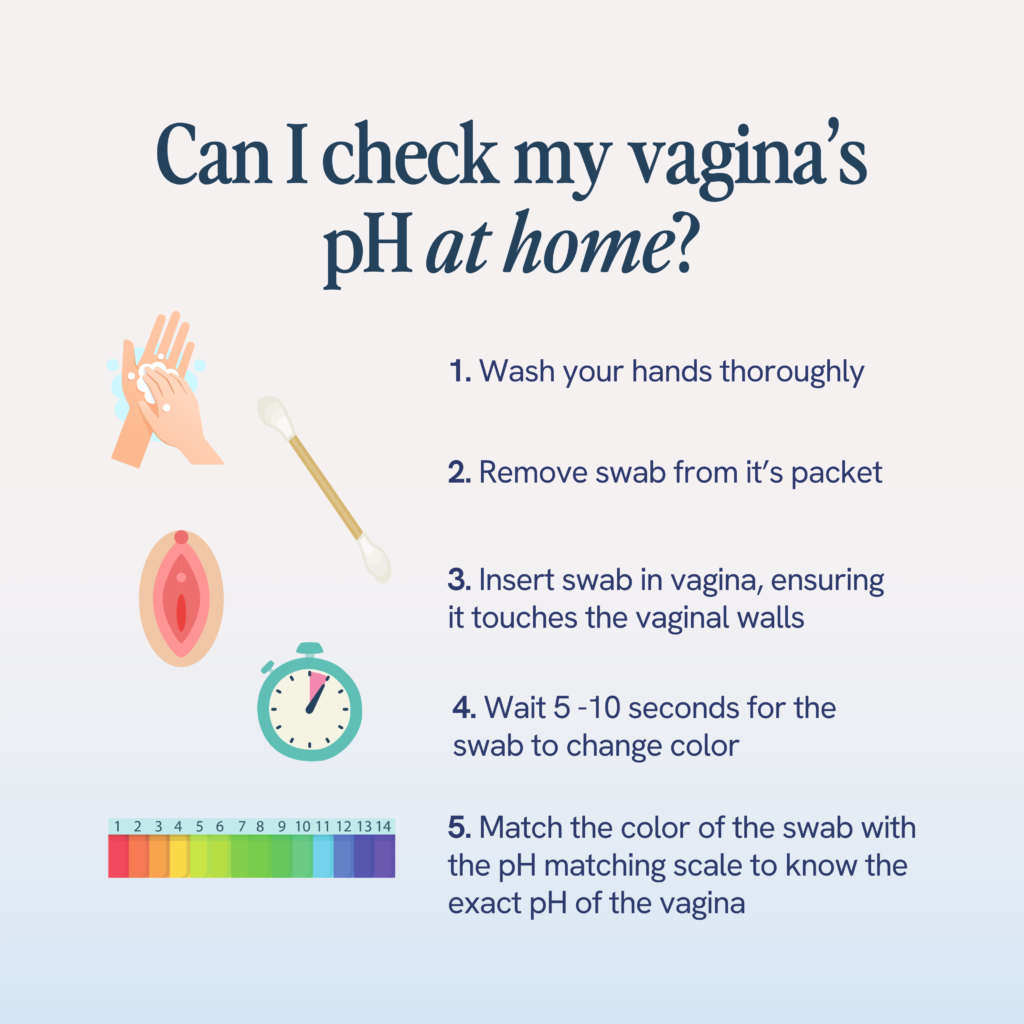
Yes! If you are ever concerned or curious about your vaginal pH, there are over-the-counter vaginal pH test kits that are easy to purchase at your local pharmacy and even easier to use.
These kits generally consist of a swab and a pH-matching scale. Before using one of these over-the-counter kits, make sure you wash your hands thoroughly. Then carefully remove the swab from its packet and insert it in your vagina. Make sure that it touches your vaginal walls. Wait 5 to 10 seconds for the swab to change its color. Now match the color of the swab with the pH matching scale to know the exact pH of your vagina.
This is a means to check vaginal pH at home and is not intended as to accurately self-diagnose bacterial vaginosis. If you suspect you have BV, it is important to seek medical attention for a professional opinion.
What can cause my vaginal pH to become off-balance?
The vaginal microbiome is complex and delicate, and many things can cause disruptions that change vaginal pH. Here are some of the most common.
Menstruation and menstrual blood
We know, we know. Along with all the other annoyances associated with your period, it also leads to potential pH changes. 8 This is because menstrual blood has a pH greater than 7, and when this blood stays in contact with your vagina through a tampon or pad, it can disrupt the pH of your vagina. This is one of the reasons it’s so important to change tampons and pads frequently.
Tight or non-breathable underwear
Most women’s underwear is made up of silk or nylon, both of which are not great for overall vaginal health. These synthetic materials are non-breathable, meaning they trap moisture, aiding the growth of harmful bacteria.
Vaginal creams, lotions, and scented cleansers
Many vaginal creams, lotions, and gels contain chemicals that can alter your vaginal pH levels9.
The same goes for scented vaginal deodorants, soaps, and shampoos.
Though these products claim to “cleanse” your vagina, they can actually make it less hygienic by increasing the likelihood of infection. Our advice, and the advice of medical professionals, is to ditch these products in favor of daily vulva cleansing with a gentle, hypoallergenic liquid wash. 9
Douching
Douching is another standard “cleansing” method that most OB/GYNs advise against. That’s because douching can wash away that good Lactobacillus bacteria that keeps your vaginal pH balanced, putting you at greater risk for infection.
Overuse or misuse of antibiotics
Don’t get us wrong, antibiotics are often the best, most effective way to eliminate a severe bacterial infection. But they are not without risk, so they should only be used when necessary and not for prolonged periods.
The way antibiotics work is not simply by killing the bacteria causing the infection but by killing all the bacteria in the body. Which means they can kill good along with bad.10 And as we know from earlier in this article, without that good Lactobacillus bacteria living in the vaginal microbiome, the vagina is more prone to pH imbalance and infection.
Birth control methods
Certain birth control methods, particularly hormonal birth control pills, intrauterine devices (IUDs), spermicides, diaphragms, or cervical caps, have been shown to alter the normal vaginal pH which may subsequently trigger an infection. 11
Poor hygiene and improper wiping
Even though we are all the way down at risk factor #7, this is one of the most common reasons for poor vaginal health. Common poor hygiene practices include not cleaning your vagina after sexual intercourse, wearing tampons and pads too long, and not wiping correctly after going to the bathroom.9 Because, yes, there is a right way to wipe your butt (from front to back, just FYI).
Having unprotected sex
Did you know the job of semen is literally to elevate your pH? It’s true. Semen has a higher pH, around 7-8, and when it comes in contact with your vagina, it raises the pH in your vagina to make it easier for sperm to swim. Generally, this elevation is temporary, but frequent unprotected sex can raise vaginal pH levels more permanently. Also, unprotected sex exposes you to potentially harmful bacteria and microbes from your partner’s microbiome.
Menopause
Estrogen is an essential female hormone for women’s health. That’s because estrogen helps your vagina lubricated by promoting glycogen production and producing normal vaginal discharge. But during menopause, estrogen levels fall, which leads to an imbalance in vaginal pH. Typically, those experiencing menopause have a pH level above 5.3. 2
Pregnancy
Just about everything is in flux when you are pregnant, including your vaginal pH. This can be attributed to changes in hormones and an overall weakened immune system. 12
Having multiple or new sex partners
Who you have sex with is 100% your choice, but it’s important to know that if you’re struggling with pH imbalance and frequent infections, new sex partners introduce your body to new bacteria and microbes, increasing the incidence of both.
Lubricants
Lubricants are used to reduce vaginal dryness during sex, but many also have a pH higher than 4.5, which can, in turn, increase your vaginal pH.
Can my pH levels become unbalanced if I’m not having sex?
Yes. Though you’ll see above that sex and unprotected sex play a role in vaginal pH imbalance, other causes, like antibiotic use and poor hygiene, are not related to sex and are very common causes of pH imbalance.
What can I do to restore or maintain a healthy vaginal pH?

We’re so glad you asked. Here are some of the top things you can do:
- Get daily probiotics since they will help increase the number of good bacteria in your system and replace bad ones. 13 Foods like yogurt, kefir, kimchi, sauerkraut, and miso are all rich with probiotics, but many find it easier to take daily oral probiotic supplements. If you do take a supplement, look for one like Happy V’s Prebiotic + Probiotic that contains that super healthy Lactobacillus.
Our Happy V® Prebiotic + Probiotic was created for anyone who is experiencing symptoms related to Bacterial Vaginosis and Yeast Infections. Eliminate the odor, itch, gut bloating, and other symptoms.
- Stay hydrated! If your vaginal walls are hydrated, water can help flush out unwanted harmful bacteria from your vagina, particularly those known for throwing off vaginal pH.
- Eat plenty of fresh fruits and vegetables, particularly those that contain Vitamin C, cranberry, and elderberry extracts, since all have potent antioxidant and anti-infective properties. These foods naturally boost your immune functions and reduce inflammation and swelling. Many of them, like citrus fruits, are also naturally acidic, which helps keep your vaginal environment slightly acidic, too.
- Cut down your sugar intake. Artificial sugars in beverages, sweetened cereals, and sweets can cause a spike in blood sugar levels. Higher blood sugar levels can suppress your immune system, allowing harmful bacteria and yeast to grow.
- Avoid vaginal cleaning products, vaginal deodorants, and douching since they introduce chemicals that can fluctuate vaginal pH levels.14 The best way to keep clean is to wash your vulva with warm water and mild, unscented soap. If you are concerned about vaginal odor, don’t try to cover it up with a product. Make an appointment with your doctor instead.
- Take antibiotics only for acute infections, i.e., if you have an infection with severe symptoms such as swelling, inflammation, pain, and other symptoms. And when you do have to take antibiotics, take them in tandem with a daily probiotic supplement to replenish your body with good bacteria.
- Wear cotton underwear. Cotton is much more breathable than silk or nylon, allowing your vagina to breathe and not trap harmful bacteria.
- Have fun, but safe sex. Remember that having a sexual partner or partners along with unprotected sex introduces your body to bacteria, microbes, and other pH-altering pathogens. Use a latex condom and make sure to wash your vulva area with warm water and soap after.
- If you are having protected sex and struggling with abnormal pH and infection, consider switching your condoms to latex-free. Certain latex condoms have ingredients that can cause irritation and pH level changes.
- Keep stress levels in check since the cortisol produced during stress can profoundly impact your vagina’s pH regulation.
Check out Happy V Pre+Pro which includes probiotic proven to help with rebalancing vaginal pH!
- A-
- A+
Check out Happy V Pre+Pro which includes probiotic proven to help with rebalancing vaginal pH!
